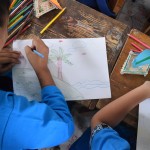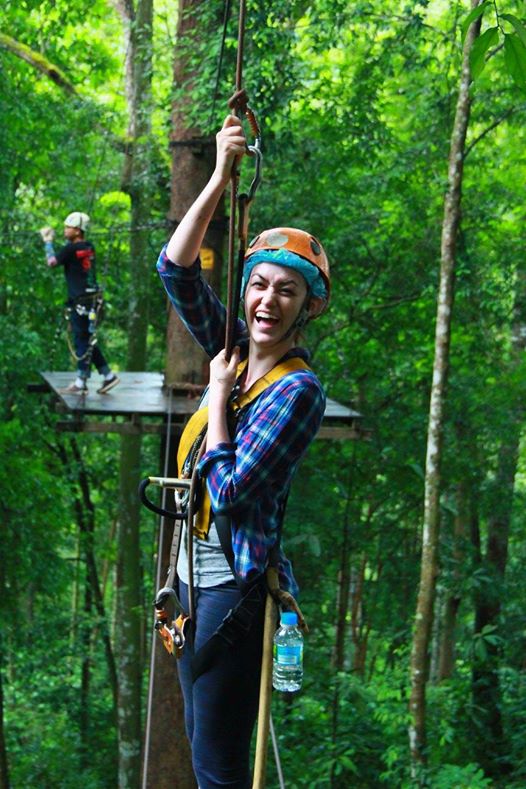After about 36 hours of travel, I touched down in Chiang Mai. After months of preparation, it was incredibly surreal to actually be in the city. I was definitely a bit nervous when I arrived, but after a weekend of adventuring around the city, catching up on sleep, and getting to know the other volunteers, I began to feel right at home. I began on Monday with an orientation with Wad, the executive director of Cultural Canvas Thailand (CCT), and a few other new volunteers. We went to a cute coffee shop and drank Thai tea while he welcomed us to the country and discussed the program and our accommodations. He also talked about the incredible things to do in Chiang Mai and Thailand, which got me very excited for all the exploring ahead!
My placement with Urban Light begins today (or tomorrow, depending on where in the world you’re reading this), so in the meantime, I’ve been volunteering with CCT’s organization, Art Relief International (ARI). CCT/ARI partners with organizations and schools all around Chiang Mai to provide art workshops and activities. The purpose of each workshop depends on the needs of the recipient. CCT/ARI truly covers a huge spectrum, doing everything from creative English lessons with young temple school students to music/art therapy projects with adults with disabilities. You can read more about their programs on their blog.
After a brief orientation on Tuesday, the new ARI volunteers and myself jumped right into assisting the other volunteers with their workshops. On Wednesday, we made paper plate jellyfish at Hope Home, an orphanage for children with disabilities. I paired up with a boy who has cerebral palsy who generally only has motor control over his feet. He was very sweet and had a great sense of humor. We had a lot of fun as he painted his jellyfish (and occasionally some of the other children!) with his toes. On Thursday, we went to a temple school, Baan King Kaew, where the students made popsicle stick puppets with us until their parents picked them up. Each student chose from a list of ten jobs (doctor, dancer, police officer, etc.) to base their puppet on, and then had to write the English word for it on the stick. They seemed to enjoy the activity, but the language barrier definitely made it challenging to communicate. On Friday, we went to another temple school, Wat Pa Pao, and had the students create an island scene using English vocabulary. In the afternoon, we did an art project at Healing Families, an organization that provides a space for adults with disabilities to learn, grow, and have fun. They’re also a social enterprise, weaving clothing to sell to support the organization! For our art project, we each painted a piece of a larger portrait to put together at the end for a full picture. The people were very kind and affectionate, and had a lot of fun designing their own piece of the puzzle.
- A little music session at Hope Home before we begin painting
- Painting at Hope Home
- Making puppets at Baan King Kaew
- Baan King Kaew students getting creative with their puppets
- Wat Pa Pao temple school
- Wat Pa Pao students worked hard on their island drawings!
- Secret Portraits at Healing Family
- The final painting at Healing Families
Volunteering with ARI for the week was a great introduction to Chiang Mai and the wonderful work taking place here. Some other interesting lessons of the past week included:
- The language. I knew Thai was a tonal language, but didn’t know exactly what that meant until my first Thai lesson. Essentially, the inflection you use when pronouncing a word (medium, high, low, rising, or falling) changes the meaning of the word completely and IT IS SO HARD. There was about two seconds at the beginning of the lesson, when our teacher had us sing “doh re mi” to find the medium tone, that I thought “oh! Tonal is like singing! I can sing! I’m gonna be fine.” NOPE. I was terrible. It is so hard to hear the pitches. Literally, you can say the same word, but the different tones change the meaning entirely. For example, the Thai word glai with a medium tone means far, and glai with a falling tone means near. One tonal mistake could lead to a substantial miscommunication!
- The wai. This is how Thais respectfully greet or thank each other in Thailand. To wai, put your hands together in a sort of “prayer” position, and bow your head. The angle that you bow and the placement of your hands (forehead, nose, chin, or chest) varies depending on who you are greeting. The highest level of respect is shown to the Buddhist monks.
- Which side of the road? In Thailand, they drive on the left side of the road, which has been quite an adjustment for me!
- Pricing. The US dollar is strong in Thailand, so compared to American prices, things are really cheap. However, I’ve already started “thinking like a Thai person” and bargained for lower prices or decided against purchasing something because it cost 100 baht (the equivalent of about $3).
All in all, it’s been an amazing first week in Chiang Mai. I am so excited to spend the next six months here, absorbing the Thai culture. In addition to all the learning, I’ve gotten a Thai massage (it was actually rather painful... they do not hold back!), pet a tiger, ziplined through the jungle, shopped at the night bazaar, got sick from eating raw vegetables, got sick from riding in a car up the winding mountain, got sick from riding in a van through the winding city streets, talked with a Buddhist monk, finally saw Wonder Woman in the cinema (with Thai subtitles), went to church on the back of my friend’s motorbike, visited some amazing temples (including Wat Phra That, the temple at the peak of Doi Suthep mountain. My Thai teacher said if you haven’t visited Wat Phra That, you haven’t been to Chiang Mai! We went at sunrise, and it was absolutely stunning.), bought a Thai cell phone, made friends from all over the world, ate several kinds of incredible Thai food that I’m still learning to call by the correct name, used the “hot water machine” in our volunteer house to shower, and lived without air conditioning in a very hot and humid climate. I am loving it here and can’t wait to begin my work at Urban Light today. I’ll check back soon! Kawp koon ka (thank you) for reading!
- The view from my room
- The night bazaar
- Petting a tiger (!!!)
- Ziplining!
- Ziplining with these adventurous friends
- Thai tea & herbal water
- The Sunday night bazaar
- Chiang Mai at sunrise from the top of Doi Suthep
- The lookout at Wat Phra That on Doi Suthep
- Hanging with a monk on top of Doi Suthep!
- Wat Phra That on Doi Suthep
- Wat Phra That on Doi Suthep
- Wat Phra That on Doi Suthep
- Wat Phra That on Doi Suthep





















